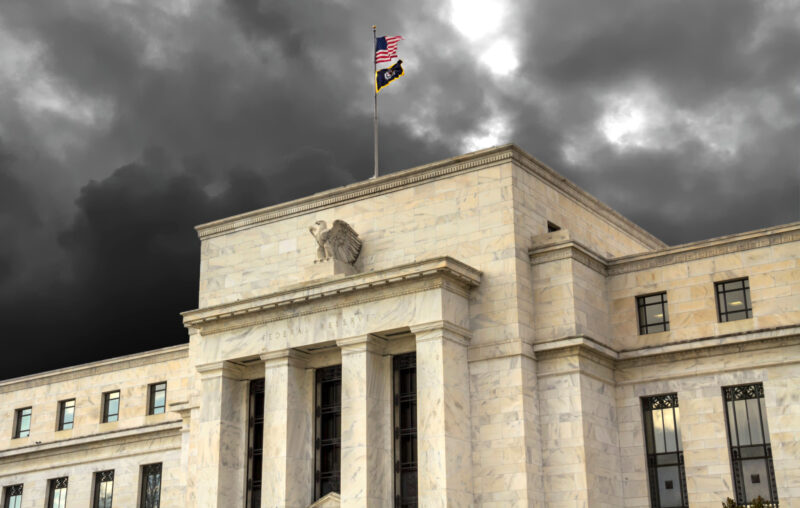
Federal Reserve Chair Jerome Powell just recently affirmed prior to Congress on the present state of the United States economy. In addition to financial policy, Powell was questioned about the Fed’s regulative propositions relating to cryptocurrencies and climate-related monetary dangers.
Hardly pointed out, nevertheless, was the Fed’s balance sheet. The Fed has actually experienced considerable operating losses over the last 6 months, which have actually tired its current capital. Those losses represent inescapable profits to the United States Treasury.
Operating losses
In the post-pandemic duration, the Fed broadened the cash supply considerably to support a speedy financial healing. It did so by acquiring huge quantities of United States Treasury bonds and mortgage-backed securities. While those possessions looked like excellent financial investments initially, they are now a significant hole in the Fed’s monetary position.
When the bulk of the Fed’s quantitative easing (QE) programs occurred in 2020 and 2021, market rates on long-lasting Treasury bonds varied mainly in the variety of 1.5 to 2.0 percent. At the time, the Fed was paying interest on bank reserves and over night reverse repurchase ( ONRRP) contracts of 0.15 or less. The Fed benefited on the distinction in between the greater rate it got from its bond purchases minus the lower rates it paid on reserves and Overnight Reverse Repurchases (ONRRPs).
Now, the Fed has actually raised the interest it pays to 4.55 percent on ONRRPs and 4.65 percent on bank reserves, however the rates it makes on its QE purchases stay mainly the same. Presuming, as a rough approximation, that the bonds it bought pay a typical rate of 1.75 percent, and the typical rate paid on bank reserves and ONRRPs is 4.6 percent, then the Fed is paying about 2.85 percent each year more than it gets on its $8 trillion dollar securities portfolio. That’s a loss of $228 billion each year!
The insolvent reserve bank
The Fed is insolvent– and I do not simply indicate intellectually.
Like a personal bank, the Fed preserves some level of capital as a buffer versus losses. When those losses surpass the worth of its capital, the Fed ends up being insolvent, indicating the liabilities it owes to others are higher than the overall worth of the possessions it holds.
The newest information reveal that the Fed owes the Treasury over $41 billion, which surpasses its overall capital. The Fed, by typical requirements, is certainly insolvent.
Stealthily postponed possessions
What does the Fed do when its liabilities surpass its possessions? It does not enter into legal personal bankruptcy like a personal business would. Rather, it develops fictitious accounts on the possessions side of its balance sheet, referred to as “deferred possessions,” to offset its increasing liabilities.
Deferred possessions represent money inflows the Fed anticipates in the future that will balance out funds it owes to the Treasury. As the Fed explains, “the deferred possession is the quantity of net revenues the Reserve Banks will require to recognize prior to their remittances to the United States Treasury resume.” The Fed had actually currently accumulated $41 billion in deferred possessions, and the quantity is just getting bigger.
The benefit to postponed possessions is that the Fed can continue its regular operations without disturbance, although thinking about the 40-year-high inflation, its current efficiency has actually been less than perfect.
The drawback is that, at a time when the Fed is currently getting worse the United States financial position by raising rate of interest (and for that reason interest payments on the federal financial obligation), it is additional robbing the Treasury of incomes by postponing them into the future. Those credits, naturally, need to be taken on by American taxpayers till the Fed’s remittances resume.
These losses might be balanced out by any previous gains on the Fed’s QE portfolio, however evaluating the net impacts of those actions is much more hard. QE has actually developed huge distortions in the monetary system. The Fed’s rate of interest tools of interest on bank reserves and ONRRPs have actually considerably cut short-term loaning in the banking and monetary systems.
A task for Congress?
In addition to its function in handling the cash supply, the Fed is the main regulator of many United States banks. If any personal bank acted this irresponsibly, regulators, such as the Fed or Federal Deposit Insurance Coverage Corporation (FDIC), would require it to close. Bank supervisors would lose their tasks and earnings.
Plainly, Congress is not preparing to close down the Fed, and is not likely to penalize it for its bad efficiency, however there are modifications that might be made. The banks that are members of the Federal Reserve System might be required to cover the capital deficiency, as explained in the Federal Reserve Act. The Fed might go back to a passage system of financial policy, leading to lower interest paid on bank reserves and ONRRPs relative to market rates and for that reason less reserves held at the Fed.
Diminishing the Fed’s balance sheet would make another Fed insolvency less most likely, while likewise minimizing the Fed’s footprint and the distortions it develops in the monetary system. At extremely least, Fed authorities need to much better handle its operations so as not to be a drain on American taxpayers once again in the future.
